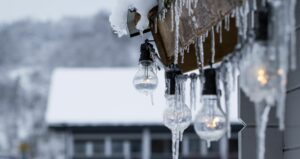
As we enjoy the beautiful season of autumn in the Midwest, Mother Nature doesn’t want us to get too comfortable. Winter will soon be here. And just in case the falling leaves and chilly nights haven’t tipped us off, local wildlife have been dropping some pretty strong hints about the impending change in seasons. Birds are beginning to make their way south. The squirrels are staying busy as they load up on all the nuts they can find. What’s their focus? Ensuring a safe and secure winter. It’s time to follow their lead and get our homes ready for snow and ice.
One common winter problem is ice damming. Is your home equipped to prevent it? Odds are, if you’ve had ice damming happen before, you will likely experience it again. It’s time to correct the problem, before winter’s onslaught. Doing so will protect your home and prevent costly damage and repairs.
Ice damming occurs after a heavy snowfall, when a block of ice forms at the bottom edge of the roof just above the gutter. When the snow above the ice dam melts (from heat rising from the attic below), that water is unable to drain off the roof because it can’t reach the gutter. It has nowhere to go but backwards up the roof and under the shingles above. As the water continues to back up under the shingles, it eventually overflows behind them, leaking into your home and causing damage to your roof (see this video). The repeated expansion and contraction of freezing and thawing can cause structural issues including tearing up shingles and even separating gutters from the house. Eventually, water can get into ceilings and walls. What comes next? Warping, mold, collapsing ceilings — you get the picture.
Prevent ice damming now…
Several different approaches can help prevent ice damming. Properly insulating and ventilating your attic is key. Consult a contractor that specializes in attic insulation and ventilation. It’s important to get it done right, and to follow proper safety practices. If you are planning to replace your roof this fall, now is the ideal time to put a complete system in place to prevent ice damming. In addition to the proper installation of insulation and ventilation, make sure your roofer installs rubberized ice shields below the lower three to six feet of shingles (depending on the roof), for the best protection.
If you don’t plan to get a new roof, another method to control ice damming is to install electric deicing cables along the eaves, and sometimes in the gutters themselves, to prevent water from freezing. Some deicing cables include thermostats that trigger the cables to heat up when temperatures drop. Do your homework, though, to prevent possible problems with this solution. For example, heating cables can provide uneven results and can be costly to operate (higher electric bills). (See these additional steps to prevent winter weather damage to your home.)
…Or address it immediately if it happens
If winter comes before you have taken steps to prevent the problem, there are a few quick actions you can take to get rid of an ice dam. The first step is to remain vigilant in the days following a heavy snowfall. Inspect your roof. If you find an ice dam, experts recommend everything from (1) using a box fan in your attic to cool down the warm spots on your roof and stop the melting to (2) pulling down snow from the roof with a roof rake to (3) tossing a stocking filled with calcium chloride up onto your roof to melt enough snow to provide a pathway for the melting snow to drain into the gutter. Another option is to call a roofer to clear up the problem, which may include steaming the frozen areas to melt the ice and employing proper snow-removal techniques.
As today’s leafy days and lovely crisp evenings march on toward the snow and ice of winter, it’s a good idea to take time right now to prevent ice damming. Or, at the very least, be prepared to act immediately if it occurs. The birds and squirrels are following Mother Nature’s lead. Time for us to get going, too, so that we will have a safe and secure home this winter.
by Kris A. Mainellis